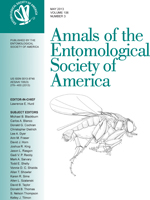Mate-seeking in Diaphorina citri Kuwayama, a vector of the economically damaging huanglongbing citrus disease, typically includes male—female duetting behaviors. First, the male calls by beating his wings at ≈170–250 Hz, producing vibrations that are transmitted along the host tree branches to the female. If receptive, she immediately replies, helping to direct the searching male toward her. The duetting and searching continues until the male locates the female. Males and females are similar in size and produce wingbeat vibrations with similar temporal and spectral patterns. A study of male and female responses to playbacks of recorded and synthetic mimics of different vibrational signals on citrus plants was conducted to better understand the range of signals to which D. citri respond and potentially to co-opt or disrupt their vibrational communication. In general, both sexes responded well to a variety of 0.3–0.5-s signals that included multiple harmonics of ≈200-Hz wingbeatfrequency chirps up to ≈1,400 Hz (where a chirp is a sine wave tone that sweeps across a narrow range of frequencies). There were only minor differences in female responses to signals containing different relative amplitudes of such chirps, and males readily located sources that played these multipleharmonic signals. The results are discussed in relation to mating-signal selectivity and the potential for developing automated methods to trap male D. citri by using vibrational signals.
How to translate text using browser tools
1 May 2013
Responses of Diaphorina citri (Hemiptera: Psyllidae) to Conspecific Vibrational Signals and Synthetic Mimics
B. Rohde,
T. M. Paris,
E. M. Heatherington,
D. G. Hall,
R. W. Mankin
ACCESS THE FULL ARTICLE
It is not available for individual sale.
This article is only available to subscribers.
It is not available for individual sale.
It is not available for individual sale.
<
Previous Article
|
Asian citrus psyllid
citrus greening disease
communication





